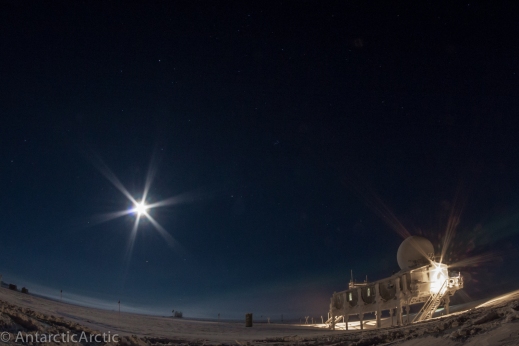On January 28th the sun returned at last! We’ve had periods of twilight each day, but the sun has not breached the horizon since November 13th. Unfortunately, it was cloudy on Saturday…but it is getting noticeably brighter each day and we will have plenty more sunrises and sunsets before we leave at the end of February! Today is cloudy again, but technically the sun rose at 10:52am and set at 12:44pm. Unlike the South Pole, where there is only one sunset each year (see my post on that here), Summit Station gets many sunrises until May 6 when it will rise and remain above the horizon until setting again briefly on August 7th. 
On the 27th the sun was very close to the horizon; a brilliant golden glow and colorful clouds hinting at its presence. On clear days this past week we have been admiring the defined earth shadow (another nice explanation of the phenomenon can be found here from Sky and Telescope) and beautiful pastel skies.

The Earth’s shadow defined to the North as we walk back to the Green House

The pink layer above the darker earth shadow is called the “belt of Venus”
The new moon on the 27th meant it was a very dark night and we had a stunning view of the stars and Milky Way as well as a few curtains of aurora. Standing beneath this spread of stars with the infinite depth of the universe spread out around us is awe-inspiring.

The Big House under the northern sky – Orion is just to the right of the dome

Standing beneath the Milky Way!
Inside our buildings we maintain our routine. We have all but finished our fresh food and rely now on frozen, dried, or canned provisions. Everyone is growing tired and looking forward to returning to the ‘real world’ soon. Part of the issue is that we are at 10,550ft above sea level here at Summit and the physiological altitude is often much higher (we’ve seen atmospheric pressure equivalent to 12,500ft this winter). Even after initial acclimatization to the altitude it’s physically exhausting. People generally don’t sleep well up here – whether due to lack of oxygen or too much/too little day light, and after a few months it’s hard to ever feel well-rested. There’s also the mind numbing routine and isolation: We’ve been cooped up in a handful of buildings with no where else to go for months now. We all knew what we were signing up for and everyone is doing quite well, but the last 2 or 3 weeks are the hardest of any season and we’re all showing signs of Toast. There is some debate as to whether this is a “real” phenomenon – whether there is actually a medical cause (lack of T3 or vitamin D or something), but regardless it affects almost everyone in winter-over crews. Some of it is comical: short term memory degrades and you walk into a room forgetting what you were doing, then do it again 2 more times. People start a sentence or a story and forget what they’re talking about half-way through. Words become hard to remember: “Do we have any more of…umm, that thing that water goes through to make coffee?” or “Have you seen my book?…and by that I mean, my hat?” And simple math becomes especially difficult. On the flip side, frustration levels run high, tempers shorten, sleep becomes difficult, and physical energy runs low. It’s a time to remember to think before you speak, and to have extra patience for everyone who is likely feeling just as burnt out as you.
It’s also a time to be aware that we are not running on “all cylinders,” and to add to that folks are excited about post-ice plans and may not be fully present and focused on the tasks at hand. We will talk about staying present and being aware of our surroundings a lot, but we have made it through the darkest times and are down to the last month of our season now!

TAWO looking very small against a clear horizon









 Last week we hit a low of -73F according to the Green House thermometers. This week however, has been dark and stormy with temps around -30F and winds around 30kn. Lots of shoveling to be done!
Last week we hit a low of -73F according to the Green House thermometers. This week however, has been dark and stormy with temps around -30F and winds around 30kn. Lots of shoveling to be done!







 We celebrated the holidays with a rare 2-day weekend and a nice dinner. The Big House smelled of baking and the atmosphere was festive with our decorated plywood tree. Everyone enjoyed a little down time to rest and catch up with family back home.
We celebrated the holidays with a rare 2-day weekend and a nice dinner. The Big House smelled of baking and the atmosphere was festive with our decorated plywood tree. Everyone enjoyed a little down time to rest and catch up with family back home.

